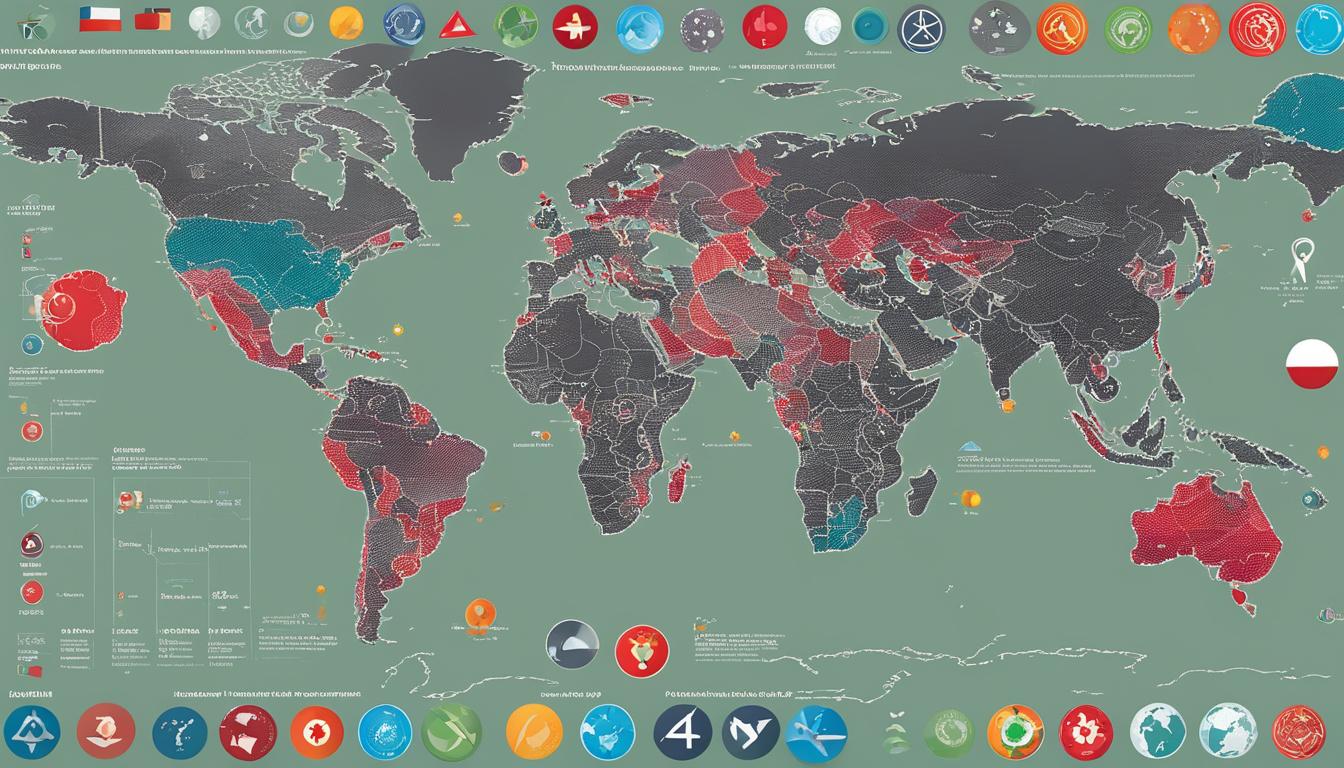Global health encompasses a wide range of issues that impact populations around the world. These challenges include communicable and non-communicable diseases, economic and social inequality, limited access to quality healthcare, environmental factors, and mental health concerns. Global health is important because it affects the well-being of people worldwide and requires a multidisciplinary approach to address these complex issues.
Key Takeaways:
- Global health encompasses a wide range of challenges, including communicable and non-communicable diseases, economic inequality, limited healthcare access, environmental factors, and mental health concerns.
- Communicable diseases, such as HIV/AIDS, influenza, malaria, tuberculosis, and COVID-19, pose significant challenges to global health.
- Non-communicable diseases, such as cancer, cardiovascular diseases, chronic respiratory diseases, and diabetes, contribute to the global disease burden.
- Environmental factors, including climate change and pollution, play a crucial role in global health.
- Health inequities and limited healthcare access are significant barriers to addressing global health challenges.
The Impact of Communicable Diseases on Global Health
Communicable diseases, also known as infectious diseases, have a significant impact on global health. These diseases can spread rapidly and have devastating effects on populations worldwide, particularly in low-income countries. Addressing the challenges posed by communicable diseases is essential to reduce the global disease burden.
Some of the most common communicable diseases include:
- HIV/AIDS: This viral infection targets the immune system, making individuals more susceptible to infections and certain types of cancer.
- Influenza: This highly contagious respiratory illness affects millions of people every year and can cause severe complications, especially in vulnerable populations.
- Malaria: This mosquito-borne disease is prevalent in tropical and subtropical regions, causing high fever, chills, and flu-like symptoms.
- Tuberculosis (TB): This airborne bacterial infection primarily affects the lungs and can be life-threatening if left untreated.
- COVID-19: The ongoing global pandemic, caused by the novel coronavirus, has had a profound impact on public health, economies, and societies worldwide.
Efforts to prevent and control communicable diseases are multifaceted and require a combination of strategies:
- Vaccination campaigns: Immunization programs play a crucial role in preventing the spread of many communicable diseases by building immunity within populations.
- Improved sanitation practices: Access to clean water, proper sanitation facilities, and hygienic practices are essential to reducing the transmission of infectious diseases.
- Healthcare infrastructure development: Strong healthcare systems and infrastructure are vital for early detection, diagnosis, and treatment of communicable diseases.
- Epidemiological surveillance: Monitoring the spread of infectious diseases, identifying outbreaks, and implementing timely interventions are critical to controlling their impact.
The global disease burden caused by communicable diseases is a pressing concern. By prioritizing prevention, early detection, and effective treatment, we can work towards reducing the impact of these diseases on global health.
Addressing Non-Communicable Diseases and Health Disparities
Non-communicable diseases (NCDs) pose significant global health challenges, contributing to a substantial number of deaths worldwide. NCDs encompass a range of conditions, including cancer, cardiovascular diseases, chronic respiratory diseases, and diabetes. These diseases are not transmitted through infectious agents, but rather arise from a combination of genetic, behavioral, and environmental factors.
The burden of NCDs is particularly high in low- and middle-income countries, where limited access to healthcare and socioeconomic disparities contribute to health inequities. Individuals from marginalized populations often face barriers to healthcare access, such as financial constraints, geographical distance, and cultural factors.
To address these challenges, comprehensive strategies are needed to promote prevention, improve healthcare access, and enhance public awareness. By implementing evidence-based interventions, governments, healthcare organizations, and communities can work together to reduce the impact of NCDs and promote health equity.
Prevention Efforts
Prevention plays a crucial role in reducing the burden of NCDs. Proactive measures, such as promoting healthy lifestyles and implementing population-wide interventions, can significantly decrease the prevalence of these diseases.
- Encouraging physical activity: Regular exercise can reduce the risk of cardiovascular diseases, certain types of cancer, and obesity. Governments can implement policies to create safe and accessible environments for physical activity, such as building parks and bike lanes.
- Advocating for healthy diets: Educational campaigns can raise awareness about the importance of a balanced diet rich in fruits, vegetables, whole grains, and lean proteins. Regulations regarding food labeling and the marketing of unhealthy products can also promote healthier eating habits.
- Promoting tobacco control: Tobacco use is a major risk factor for NCDs, including lung cancer, heart disease, and stroke. Implementing comprehensive tobacco control measures, such as increasing taxes on tobacco products and enforcing public smoking bans, can effectively reduce tobacco consumption.
Improving Healthcare Access
Unequal access to healthcare is a significant driver of health disparities related to NCDs. To address this issue, efforts should be made to ensure that all individuals, regardless of socioeconomic status, have access to affordable and quality healthcare services.
- Strengthening healthcare systems: Governments should invest in healthcare infrastructure, including the establishment of clinics, hospitals, and preventive care centers in underserved areas. This would expand healthcare access and improve early detection and treatment of NCDs.
- Reducing financial barriers: Implementation of universal health coverage and health insurance schemes can alleviate the financial burden associated with NCDs. This would enable individuals to seek timely medical care and reduce disparities in healthcare access.
- Enhancing primary healthcare: Emphasizing the role of primary healthcare in NCD prevention and management can improve health outcomes and reduce healthcare costs. Implementing integrated care models, strengthening primary care workforce, and promoting community-based programs can enhance the effectiveness of healthcare interventions.
Educating on Lifestyle Factors
Education is crucial in empowering individuals to make informed decisions about their health and adopt healthy lifestyle behaviors. By providing accurate information and raising awareness about the modifiable risk factors associated with NCDs, preventive efforts can be amplified.
- Health literacy programs: Initiating health literacy programs at schools, workplaces, and community centers can equip individuals with the knowledge and skills to make healthy choices.
- Targeted campaigns: Tailoring health promotion campaigns to specific population groups can address cultural and socioeconomic factors that influence health behaviors. These campaigns can emphasize the importance of regular health check-ups, cancer screenings, and disease prevention strategies.
Addressing non-communicable diseases and health disparities requires a comprehensive approach that encompasses prevention, healthcare access, and education. By implementing these strategies, societies can work towards reducing the burden of NCDs and promoting health equity.
| NCD Type | Global Deaths | Most Affected Regions | Risk Factors |
|---|---|---|---|
| Cancer | 9.6 million | Asia, Europe, and North America | Smoking, unhealthy diet, physical inactivity |
| Cardiovascular diseases | 17.9 million | Latin America, Eastern Europe, and South Asia | Tobacco use, high blood pressure, diabetes |
| Chronic respiratory diseases | 4.0 million | Low- and middle-income countries | Air pollution, tobacco smoke, occupational exposures |
| Diabetes | 1.6 million | Pacific Islands, Middle East, and North Africa | Obesity, sedentary lifestyle, genetic factors |
The Intersection of Environmental Health and Global Health
Environmental factors play a crucial role in global health. The impacts of climate change, air pollution, and water contamination are far-reaching and pose significant risks to human well-being. These environmental challenges have direct implications for the spread of infectious diseases, the emergence of new diseases, and overall public health.
The effects of climate change on global health are widespread and include heat-related illnesses, extreme weather events, and changes in vector-borne disease patterns. Rising temperatures can also exacerbate air pollution, leading to respiratory illnesses and cardiovascular problems. Additionally, water contamination, whether from industrial pollution or inadequate sanitation systems, can contribute to the spread of waterborne diseases and pose severe health risks.
Addressing these environmental health concerns is essential to safeguarding global health. Implementing sustainable practices, reducing greenhouse gas emissions, and promoting clean energy sources are crucial steps in mitigating the adverse effects of climate change. These efforts not only protect the environment but also have direct and indirect health benefits, reducing the burden of disease and promoting overall well-being.
Furthermore, it is imperative to strengthen environmental regulations and enhance monitoring systems to prevent pollution and ensure clean air and water for all. Collaborative global initiatives are essential in driving forward these efforts and ensuring that environmental health remains a priority in the global health agenda.
By protecting the environment, we protect our health and the health of future generations.
Key Environmental Global Health Challenges
- The impact of climate change on human health
- Air pollution and its effects on respiratory health
- Water contamination and waterborne diseases
- The spread of infectious diseases due to environmental factors
- Potential health risks from exposure to hazardous substances
Environmental Health Initiatives and Policies
The importance of environmental health in the global health agenda has led to the development of various initiatives and policies aimed at addressing these challenges. International organizations, such as the World Health Organization (WHO) and the United Nations Environment Programme (UNEP), actively advocate for environmental health and coordinate efforts to reduce pollution, promote sustainable practices, and protect public health.
For example, the WHO’s Global Action Plan for Air Pollution aims to reduce the adverse health impacts of air pollution with measures such as promoting clean cooking solutions, strengthening ambient air quality standards, and implementing policies to reduce greenhouse gas emissions. Similarly, the UNEP’s Global Environmental Health Initiative focuses on improving water quality, managing hazardous chemicals, and addressing pollution-related health risks.
These initiatives, coupled with national and local efforts, play a vital role in advancing environmental health and contributing to global health outcomes. By prioritizing environmental health and adopting sustainable practices, we can create a healthier and more resilient world for all.
| Environmental Global Health Challenges | Effects on Global Health |
|---|---|
| Climate change | Increased disease transmission, extreme weather events, worsened air pollution |
| Air pollution | Respiratory illnesses, cardiovascular problems, increased mortality rates |
| Water contamination | Waterborne diseases, gastrointestinal issues |
| Pollution | Potential long-term health effects, including cancer, neurological disorders, and developmental problems |
Tackling Health Inequities and Healthcare Access
Health inequities are a pressing issue in global health, influenced by various social, economic, and political factors. These inequalities contribute to disparities in healthcare access and outcomes, creating barriers to achieving optimal health for all individuals and communities.
While some countries boast well-developed healthcare systems, many low-income countries struggle to provide adequate healthcare to their populations. Limited access to healthcare, including financial barriers, prevents individuals from receiving timely and necessary medical attention, exacerbating global health challenges.
Efforts to address health inequities and improve healthcare access globally are crucial in promoting health equity and ensuring that everyone has the opportunity to lead a healthy life. Implementation of policies and initiatives focused on healthcare infrastructure development, health workforce training, and financial protection systems can play a significant role in overcoming these barriers.
Effective healthcare financing mechanisms, such as universal health coverage, can help reduce financial barriers and ensure that individuals can access the care they need without facing financial hardship. By prioritizing health equity, governments and international organizations can work together to eliminate healthcare inequalities and create a more equitable global health landscape.
Ensuring Universal Access to Quality Healthcare
One of the key strategies to tackle health inequities is to ensure universal access to quality healthcare. This involves addressing the structural, financial, and geographical barriers that impede individuals’ ability to seek and receive healthcare services.
1. Enhancing healthcare infrastructure: Investing in healthcare infrastructure, including hospitals, clinics, and primary care centers, is essential to expand healthcare access in underserved areas. This can help improve the availability and quality of healthcare services, making them more accessible to populations in need.
2. Strengthening healthcare workforce: Building a strong and competent healthcare workforce, including doctors, nurses, and other healthcare professionals, is crucial to ensure that there are enough trained professionals to provide essential healthcare services. This includes strategies such as investing in healthcare education and training programs, promoting workforce retention, and incentivizing healthcare professionals to work in underserved areas.
3. Addressing social determinants of health: Health inequities are closely tied to social determinants of health, such as poverty, education, and housing. Addressing these underlying social determinants can help improve health outcomes and reduce healthcare inequalities. This can be achieved through policies and interventions focused on poverty alleviation, education for all, and affordable housing.
Global Efforts for Health Equity
Health equity is an ongoing global endeavor that requires collaboration and coordination among governments, international organizations, healthcare providers, and communities. Several initiatives and organizations are working towards achieving health equity and improving healthcare access worldwide.
“Ensuring health equity demands a focus on the most vulnerable populations, striving to eliminate the barriers they face in accessing healthcare and promoting their social well-being.” – World Health Organization
The World Health Organization (WHO), as a leader in global health, has been instrumental in advocating for health equity and addressing healthcare inequalities. Through their initiatives, such as the Universal Health Coverage and Health for All campaigns, WHO aims to ensure that everyone can access quality healthcare services.

Other international organizations, such as the United Nations and non-governmental organizations like Doctors Without Borders, are also actively involved in promoting health equity and improving healthcare access in underserved regions.
By working together, sharing best practices, and implementing evidence-based interventions, we can create a future where healthcare inequalities are minimized and health equity is a reality for all.
Global Health Challenges Wrap Up
Addressing global health challenges requires a collaborative approach involving governments, international organizations, healthcare professionals, and individuals. Through global health initiatives, organizations like the World Health Organization (WHO) and the United Nations (UN) have made significant strides in tackling these complex issues.
Advancements in healthcare technology, research, and education hold promise for improving global health outcomes. Innovation in medical devices, digital healthcare solutions, and telemedicine have the potential to bridge healthcare gaps and increase access to quality care, especially in underserved areas.
Looking ahead, the future of global health depends on continued collaboration and investment. It entails strengthening healthcare systems, supporting healthcare initiatives in low-income countries, and prioritizing health equity. By working together and investing in global health, we can create a healthier and more equitable world for all.
Learn More About International Travel Nursing
What are some of the global health challenges today?
Global health challenges include communicable and non-communicable diseases, economic and social inequality, limited healthcare access, environmental factors, and mental health concerns.
Which diseases pose significant challenges to global health?
Communicable diseases such as HIV/AIDS, influenza, malaria, tuberculosis, and COVID-19 are major challenges to global health.
What can be done to address communicable diseases?
Efforts to prevent and control communicable diseases include vaccination campaigns, improved sanitation practices, and healthcare infrastructure development.
What are non-communicable diseases and why are they a concern?
Non-communicable diseases, such as cancer, cardiovascular diseases, chronic respiratory diseases, and diabetes, are major global health concerns due to their high burden of mortality.
How do health disparities contribute to non-communicable diseases?
Health disparities, including unequal access to healthcare and socioeconomic factors, contribute to the unequal distribution of non-communicable diseases.
How do environmental factors impact global health challenges?
Environmental factors such as climate change, air pollution, and water contamination have significant impacts on human health and contribute to global health challenges.
How can we address environmental health concerns?
Protecting the environment and promoting sustainable practices are essential to mitigate the adverse effects on global health.
What are healthcare inequalities and why are they a concern?
Healthcare inequalities result from social, economic, and political factors, and can contribute to disparities in healthcare access and outcomes.
What are some barriers to healthcare access?
Lack of access to healthcare, including financial barriers, limits the ability to address global health challenges effectively.
How can we improve healthcare access and address health inequities?
Efforts to improve health equity and ensure universal access to quality healthcare are critical in overcoming barriers and addressing global health challenges.
How can global health challenges be addressed?
Global health challenges require coordinated efforts from governments, international organizations, healthcare professionals, and individuals. Global health initiatives and advancements in healthcare technology, research, and education play crucial roles in addressing these challenges.




